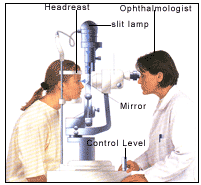|
|
Conductive Keratoplasty (CK ): A New Procedure for the Farsighted
 CK (Conductive Keratoplasty) is the first non-laser procedure
for farsightedness(+ 0.75 to +3 diopters). The farsighted patient has a cornea
that is too flat. Too little curvature of the cornea causes the light coming
into the eye to focus somewhere behind the retina resulting in blurred distance
and near vision. CK reshapes the
cornea to give it a steeper curvature, moving
the focus to the retina. CK (Conductive Keratoplasty) is the first non-laser procedure
for farsightedness(+ 0.75 to +3 diopters). The farsighted patient has a cornea
that is too flat. Too little curvature of the cornea causes the light coming
into the eye to focus somewhere behind the retina resulting in blurred distance
and near vision. CK reshapes the
cornea to give it a steeper curvature, moving
the focus to the retina.
Presbyopia, the type of farsightedness that occurs during middle
age, begins to take effect on people in their early forties and affects everyone
by the age of fifty. Gradually newsprint becomes more difficult to read at close
distances, as the words appear smaller.
 Symptoms of
farsightedness
Symptoms of
farsightedness
 Begin needing glasses after age 40. Begin needing glasses after age 40.
Currently wears
bifocals.
Difficulty reading menus, computer screen, the alarm clock, or
driving at night.
Eye fatigue when reading in poor lighting or at the end of the
day.
Trouble changing focus from distance to near.
Constantly repositions reading material in an attempt to find
the right focus.
As the first alternative to laser for farsightedness, CK
represents a revolutionary option for those patients who thought they'd never
be rid of their glasses.
 Who can be a candidate for CK
Who can be a candidate for CK
 This procedure is for patients who need only reading glasses,
have excellent distance vision, and have had good vision all of their lives. This procedure is for patients who need only reading glasses,
have excellent distance vision, and have had good vision all of their lives.
The average age of patients is between 54 and 55. Safe and fast,
CK usually produces results in a weeks time.
To go in for surgery you should have no physical conditions such as
diabetes,
pregnancy, or pacemaker
You should meet with an ophthalmologist to consider other qualifications to
determine if you will be a successful candidate
 Procedure
Procedure
CK is performed with a small pen shaped instrument inserted into the cornea.
This customized instrument emits and controls radiofrequency energy (RF) into
the eye, producing heat that makes the cornea steeper. Before surgery, the
doctor will map out a pattern of 8, 16, 24, or 36 treatment points. The probe is
then inserted at 80% of corneal depth at each point.. RF is then distributed to
each point through the Keratoplast tip at a rate of 0.6 millijoules at 0.6
seconds, changing the shape of the cornea. The result of this changes the way
the cornea directs light to the rest of the eye.
CK has the highest safety profile of any refractive
procedure that has been approved by the FDA.
|
CK takes about 3 to 5 minutes per eye, and usually only one eye is done. Pain
is reduced during surgery through the use of a topical anesthetic in the form of
eye drops. When necessary, a mild sedative can be given to patients who need to
be more relaxed. The procedure is relatively painless, involves no cutting, and
can be done in the doctor's office or clinic. For patients who require treatment
in both eyes, CK is typically performed on both eyes on the same day one eye
immediately after the other.
After the surgery:
It is normal to have light sensitivity and some blurriness in the first few
weeks after the surgery. Tearing is also normal with extended reading in the
first few weeks. During this time you will be able to work and function well,
using the untreated eye. No patch is needed.
What to Expect after CK:
-
Take antibiotic eye drops 4 times daily for 1 week
-
Doctor checkups at 1 day, 1 week, and 1,3,6, and 12 months
-
Improved vision within a weeks time
-
Must avoid getting contaminated water, soap, and sweat in eyes.
Patients are advised to avoid hot tubs, swimming pools and bodies of water
like lakes and oceans for two weeks.
-
Avoid wearing eye makeup
-
Possible scratchiness or
foreign object sensation in eye
-
98% of patients could read newspaper print at twelve month follow up
Once the healing is complete, you can expect good reading for most
tasks: menus, alarm clocks, computer work, prices on store shelves, and golf
scorecards. Extended reading of small print may require stronger reading
glasses.
As the eye needs more strength with increasing age, enhancements to the
initial treatment can be performed.
Side Effects of CK
Some side effects of the procedure include: double images, halos, blurry
vision, and original over-correction. These side effects occur in a very small
percentage and are almost always reversed by the twelve-week checkup.
Cost
The average cost of CK runs from about $1,000 to $1,800 per eye. Because this
is considered elective surgery, it is usually not covered by health insurance.
However, many practices make financing options available to their patients.
Related Links
|
|
|
|
|









